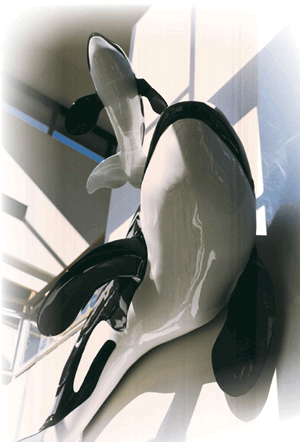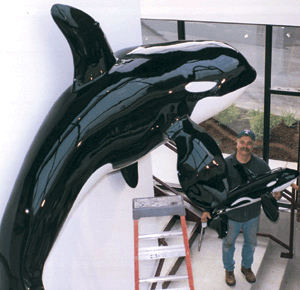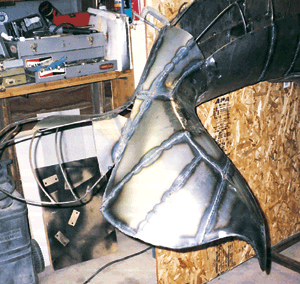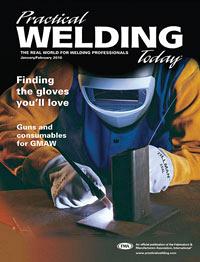Contributing Writer
- FMA
- The Fabricator
- FABTECH
- Canadian Metalworking
Categories
- Additive Manufacturing
- Aluminum Welding
- Arc Welding
- Assembly and Joining
- Automation and Robotics
- Bending and Forming
- Consumables
- Cutting and Weld Prep
- Electric Vehicles
- En Español
- Finishing
- Hydroforming
- Laser Cutting
- Laser Welding
- Machining
- Manufacturing Software
- Materials Handling
- Metals/Materials
- Oxyfuel Cutting
- Plasma Cutting
- Power Tools
- Punching and Other Holemaking
- Roll Forming
- Safety
- Sawing
- Shearing
- Shop Management
- Testing and Measuring
- Tube and Pipe Fabrication
- Tube and Pipe Production
- Waterjet Cutting
Industry Directory
Webcasts
Podcasts
FAB 40
Advertise
Subscribe
Account Login
Search
Whale watching: A doctor's love of whales leads to a complex welding project
- By Dianna Dearen
- June 15, 2001
- Article
- Arc Welding
Orcas, or killer whales, have many of the characteristics loved and respected by man. Their size, strength, and speed allow them to hunt a range of fish, birds, and aquatic mammals, earning them the reputation as the ocean's top predator.
They are intelligent animals that can be friendly to humans and trained as performers in aquarium shows. Orcas have family values, so to speak, living together in large pods.
Most of all, they are known and loved by humans for their unique beauty, with a striking black and white skin that sets them apart from all other whales.
Whales, and orcas in particular, have gained respect and popularity in the U.S. for more than a decade thanks in large part to news coverage of SeaWorld's famous resident Shamu, the "Free Willy" movies, elaborate building murals by the sea-life-inspired artist Wylan, and political calls for their protection from whalers.
"It's just amazing to be out there when your 20-foot boat is surrounded by 30 whales," said Dr. Michael Kaufman, a chiropractor and part-time whale watcher from Bothell, Wash.
Kaufman's interest in whales led him to commission part-time metal artist James Berry, who also is one of his patients, to create a mother orca and calf sculpture for the Kaufman Building, which opened September 28, 1998, in Bothell (see Figure 1).
Kaufman had been planning to build a new office for himself and other doctors for several months, so Berry was not surprised when he showed him blueprints for the project during a routine medical visit more than a year ago. To his surprise, however, Berry was given his biggest metal art project to date before he left the office that day.
A Whale of a Project
Originally, Kaufman wanted the whales to be close to the ground or outside so that people could get close to them and touch them. Kaufman scrapped that idea when he realized that kids' climbing on the sculpture could pose a danger to themselves, Berry said.
Making the orcas appear lifelike was most important for both men. From January to late September 1998, Berry perfected the whales, with Kaufman stopping by often to admire his handiwork and to make comments.
"He's a stickler for detail," Kaufman said of Berry. "If I didn't like something, he'd cut it off and start over."
Berry, who attended the Hobart Institute of Welding, Troy, Ohio, after high school, has been welding for more than 20 years and now works full time as a machinist in Washington. He started his art business, Beyond the Garden Gate, three years ago to work on part-time projects such as gates and arbors.
The most amazing aspect of the whale project, according to Berry, was doing it in a 12- by 16-foot shop outside of his home. The whales were so large he had to cut a larger door to move them out for painting.
He worked for more than nine months on the whale assignment, which took a lot of his spare time. It was particularly hard to commit to the project on pleasant summer days when he wanted to play with his then-8-year-old son Nickolas, Berry said.
Even his wife, Amy, who is a design and artistic adviser for the business, contributed to the project. "She'd close her eyes and run her fingers over it," Berry said. "And she would suggest things."
The mother whale was welded first. Berry started with a wire frame of 1/4-inch-diameter hot-rolled steel mounted to plywood. He later mounted it to a freestanding cart. Berry used the same process for the calf, which he began in June.
To familiarize himself with their structure and movement, Berry researched whale photos at a local library, and a brochure photo Kaufman had brought back from a whale watching excursion also was used as a model.
Gas metal arc welding (GMAW) was used for the entire project (see Figure 2). "For doing the seams, it [GMAW] worked great for all the multiposition welding," Berry said. During the project, the larger whale was flipped three times—twice for welding and once to apply the finish coating.
Regular mild steel was used because of its workability, meaning that it is thin enough to bend and thick enough to weld without a lot of trouble, he said. All forming was done with a 24-inch hand sheet metal roller. For the exterior of the sculpture, Berry welded 18-gauge cold-rolled steel sheet panels to the frame.
To achieve the whales' smooth exteriors, Berry sanded them with 150-grit paper, and the low spots were filled with auto body plastic filler. He then wet-sanded them with 240-grit paper.
After sanding, the whales were relocated via a rented truck to a downdraft paint booth to be painted by Berry's friend, Dan McDowell, owner of Fiberglass Specialties in Snohomish, Wash. (see Figure 3). Both were coated with base and clear paint forthe finish McDowell is a paint expert from his experience restoring Corvettes, and the paint is what gives the whales their realistic look, Berry said. After painting, the sculpture was returned to Berry's home shop.
The Final Day
When the sculpture was finished, the whales were carefully moved to the building by Berry and friends. The baby orca traveled in the back of a pickup truck. Berry walked the mother with attached wheels to the building, which is a few blocks from his home.
The welding did not stop in Berry's shop. Because of the occurrence of earthquakes in the Northwest, extra support is needed on buildings and structures.
Washington state-certified welders from the building's construction crew assisted with the mounting, Berry said. The mother whale, which is suspended from the wall at its dorsel fin, was attached with a connection similar to a trailer hitch, which was welded to an I-beam on the elevator shaft.
"It was breathtaking to see it being put up there," Kaufman said.
Using steel rather than fiberglass, aluminum, or another, more lightweight material probably made the process more difficult for Berry and his crew, but the final product will last as long as the building stands. The finished calf sculpture is 3 feet long and weighs 25 pounds; the mother whale is 12 feet long and weighs 300 pounds.
Berry hopes the success of his first big art project will bring attention to his artwork and attract more customers. "I'd like to see Beyond the Garden Gate take off so I can do this full time," he said.
The whale project may have been the break he needed. Mounted for the grand opening of the building in September, the whales have caught the attention of many patients and visitors. The most common comment I get is 'wow,'" Kaufman said.
Photos courtesy of James Berry, owner of Beyond the Garden Gate, P.O. Box 1465, Bothell, Washington 98041, e-mail dingle@gte.net. Berry creates custom metal art sculptures and garden pieces.
About the Author
About the Publication
subscribe now

The Welder, formerly known as Practical Welding Today, is a showcase of the real people who make the products we use and work with every day. This magazine has served the welding community in North America well for more than 20 years.
start your free subscription- Stay connected from anywhere

Easily access valuable industry resources now with full access to the digital edition of The Fabricator.

Easily access valuable industry resources now with full access to the digital edition of The Welder.

Easily access valuable industry resources now with full access to the digital edition of The Tube and Pipe Journal.
- Podcasting
- Podcast:
- The Fabricator Podcast
- Published:
- 04/16/2024
- Running Time:
- 63:29
In this episode of The Fabricator Podcast, Caleb Chamberlain, co-founder and CEO of OSH Cut, discusses his company’s...
- Industry Events
16th Annual Safety Conference
- April 30 - May 1, 2024
- Elgin,
Pipe and Tube Conference
- May 21 - 22, 2024
- Omaha, NE
World-Class Roll Forming Workshop
- June 5 - 6, 2024
- Louisville, KY
Advanced Laser Application Workshop
- June 25 - 27, 2024
- Novi, MI



































